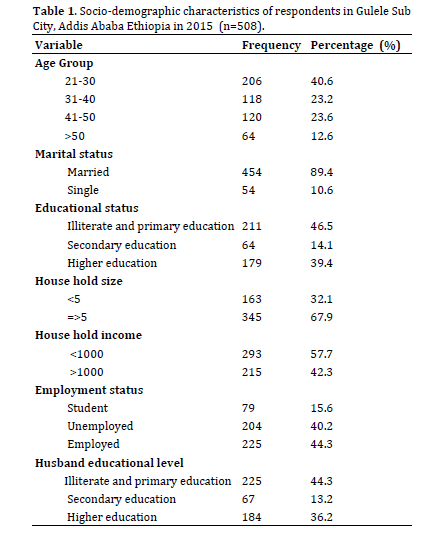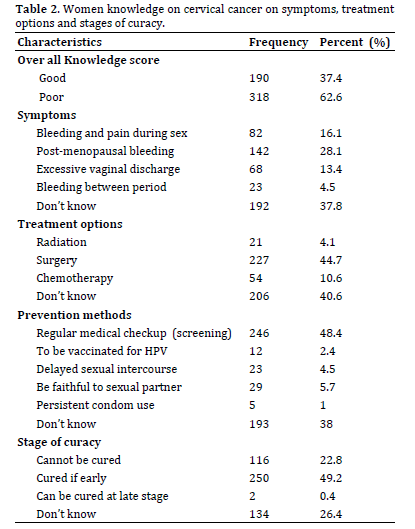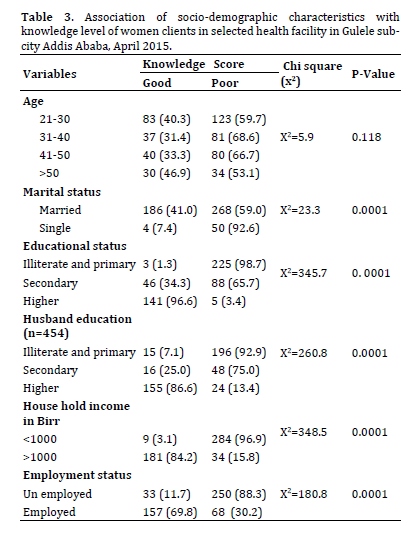Original Article - (2017) Volume 18, Issue 1
Departments of 1Public Health, 2Midwifery, College of Health Sciences, Arsi University, Assela, 3Addis Ababa Health Bureaus, Federal Ministry of Health, 4Addis Continental Institute of Public Health, Addis Ababa, Ethiopia
Received September 02nd, 2016 - Accepted October 25th, 2016
Background Worldwide, cervical cancer is second most common health problem in women. Approximately 80% of cervical cancer occurs in developing countries. The magnitude of the problem has been under recognized and under prioritized compared to health priority such as HIV/AIDS, tuberculosis and malaria. Most cases of women with cervical cancer in sub-Saharan Africa present at advanced stage of the diseases, when treatment is ineffective or not available. Therefore the aim of this study was to assess the level of knowledge of women on cervical cancer and factors affecting their knowledge for cervical cancer in women who are visiting health facility which is found in Gulele sub-city Addis Ababa. Methods A facility based cross sectional study was conducted from January-April 2015 in Addis Ababa Gulele sub city. A total of 508 study participants whose age was 21-64 years were participated in the study. Astructured interview administered questionnaire was used to assess information. SPSS window version 21 was used for data entry and analysis. Result Of all the respondents 190 (37.4) were above average knowledge on cervical cancer. The knowledge of women on cervical cancer was found to be low. Education about the disease must include information on disease symptoms, treatment options, stages of curacy and prevention methods. Conclusions The result of this study revealed that knowledge of women on cervical cancer was low. The minister of health and stakeholders should have to give focus on the national policy of non-communicable prevention strategy to be effectively implemented in health facility. Client cantered regular health education about non-communicable disease like cervical cancer in health facility is important to increase women knowledge on the disease.
Ethiopia; Uterine Cervical Neoplasms
CNI cervical intra-epithelial neoplastic; HIV human immune virus; HPV human papilloma virus; PAP papanuculeas; TB tuberculosis; VIA visual inspection with acetic acid; WHO World Health Organization
Worldwide, cervical cancer is second most common health problem in women. An estimated, 470,600 new cases and 233,400 deaths of cervical cancer occurred in the year 2000. Approximately 80% of cervical cancer occurs in developing countries [1]. Cervical cancer often grows very slowly over a period of years. Before the cancer actually develops, there are early changes that occur in the cervix. While these abnormal cells (called cervical intra-epithelial neoplastic or CIN) are not in and of themselves cancerous, and many women with these cells do not develop cancer [2]. High incidence of cervical are reported in sub-Saharan Africa as a study done in between 1981 and 1990, showed that cervical accounted for 70%-80% of all cancers of the genital tract and 8%- 20% of all cancers. Cervical cancer remains a major public health problem in developing countries, especially Africa where an estimated 53,000 women die of the disease every year. fortunately, we now have measures that unprecedented opportunities for preventing this cancer that devastates families ; efficient, low-cost screening approaches suitable for low-resource areas and vaccines that are efficacious in preventing the infections and precancerous changes that can lead to cervical cancer. All women are potentially at risk of developing cervical cancer at some point in their life time. The most common risk factors for cervical cancer include an early age of first intercourse, having multiple sexual partners and having experienced a weekend immune system. Cervical cancer is most often diagnosed in their late 30s. The most common symptoms of cervical cancer include abnormal bleeding, such as between periods or after intercourse [3].
When we come to our country Ethiopia; there is limited cytological service, smears are only taken in a hospital or clinic setting and until very recently most had to be sent abroad for analysis. Some studies show that the prevalence of invasive cervical cancer in Ethiopia was 15.6/1000 population. In many developing countries the awareness level and the screening frequency of cervical cancer is low because of different reasons; but many countries including Ethiopia include the screening and awareness creation in their national health policy. Until recently much focus is not given for cervical cancer awareness creation program that is included in the prevention of non-communicable control program in many developing countries including Ethiopia [4].
The magnitude of the problem has been under recognized and under –prioritized compared to health priority such as HIV/AIDS, tuberculosis and malaria. Most cases of women with cervical cancer in sub-Saharan Africa present at advanced stage of the diseases, when treatment is ineffective or not available. Cervical cancer is detectable and preventable through cervical cancer screening for pre-cancerous lesions (papanicolaou smear). Such screening has been effective in preventing cervical cancer in industrialized counties, where adequate health infrastructure and human and financial resources are available to ensure high quality and good coverage. However this has largely failed in most developing countries including, Ethiopia where appropriate infrastructure is not available. From different studies done in developing countries including Ethiopia the level of knowledge on cervical cancer and factors affecting their knowledge is not well known. Therefore the aim of this study was to assess the level of knowledge of women on cervical cancer and factors affecting their knowledge for cervical cancer in women who are visiting health facility which is found in Gulele sub-city Addis Ababa.
Study Area
A Cross-sectional study design was implemented the study was conducted in Addis Ababa city, the capital of Ethiopia, with population of about 2.7 million according to 2007 population census. These 35 health facilities included both health centers and hospitals of which 5 hospitals were administrated by federal ministry of health /FMOH/whereas the rest were under Addis Ababa city administration health bureau. The study was conducted from January-April, 2015. To assess the level of knowledge of women on cervical cancer and factors affecting knowledge of women on cervical cancer whose age is (21- 64) years in health facilities found in Gulele sub-city Addis Ababa Ethiopia.
Source Population: The source population for this study is all women whose age is (21-64) years who are visiting health facilities for different causes in selected health facilities found in Gulele sub-city during the study period.
Study Population: The study population is women of age (21-64) years who are visiting health facility during study period in Addis Ababa Gulele sub-city.
Inclusion Criteria: All women whose age (21-64) years who are visiting health facility at the time of data collection.
Exclusion Criteria: Patients who are unable to hear and those who have impaired conscious level.
Sample Size
The sample size was calculated using EPI info software version 7 unmatched case control.; taking the 95% level of significance(zα1/2)=(1.96)2, Margin of error (d) 5%, prevalence is 26.9% and considering a 10% non-response rate, the final sample size was 508 subjects. According to a study done in Gondar town about women awareness on cervical cancer, educational status of the women (to be illiterate) is a major factor that affects women awareness with odds ratio of 1.96 Getahun et al. [5].
Sampling Procedure
As of august 2013, Gulele sub city has ten (10) woreda. In this ten woreda there were 12 public health facilities that give service for a woman who came for different causes (Table 1). Among 12 health facilities ten (10) governmental health centers and two (2) government hospitals were found in this sub city. Five health facilities namely; Guto meda, Adisu Gebeya, Hiwot Fana and Tibeb be kechene, Shiro Meda Health Centers were selected using simple random methods. Sample size was distributed proportionally to each selected health facility.

Operational Definition
Knowledgeable on Cervical Cancer: Respondents who answer at list one points regarding symptoms, treatment options, stages of curacy and prevention methods of cervical cancer. Questions regarding knowledge of symptoms, treatment options, prevention and early detection measures for cervical cancer were scored and pulled together and the mean score was computed to determine the overall knowledge of the respondents. Average and above Score were considered as knowledgeable and below the score was poor knowledge (Table 2).

Data Collection Procedures and Quality Control
The questionnaire was prepared in English and then, translated to Amharic language (National language) for data collection purpose. The questionnaire included, socioeconomic characteristics like Age, occupation, marital status, educational status, house hold family size, house hold income, partner educational status and knowledge Assessment question like cervical cancer symptoms, prevention methods, options of treatment and stage of curacy. Before real data collection the questioner was pre tested in health facilities which was not selected in sampling procedure .The data was collected in patient exit interview. Eight (8) female diploma nurse data collectors and two (2) female B.Sc. nurse supervisors were recruited. Two days training was given for data collectors and supervisors then pretest was done avoid any difficulty during data collection period. Using similar gender ensures smooth communication between study participants (women) and the data collectors.
After data collection each completed questionnaires were cheeked for completeness, missing values and unlikely responses and then manually cleared up and incomplete questionnaires was discarded. During data analysis sorting was used to check for missed variables, outliers and other errors. If any error identified during analysis counter checking performed from original questionnaires.
Data Analysis Procedures
Data entry was performed using Epi Info version 7 and analyses was performed using SPSS version 21.0 software (SPSS Inc., IL, USA). Descriptive analyses were carried out to displayed frequency and percentages. Chi-square test was used to see the association between independent factors with knowledge score. P-Value <0.05 was considered to see significance.
Ethical Consideration
Ethical Approval was obtained from Research and Ethical Committee (REC) of Addis continental Institute of Public Health. Cooperation letter was obtained from Addis Ababa health bureau and Gulele sub city health office. Verbal consent was obtained from all participants after explaining the objective of the study during data collection. Those who are unwilling to participate in the study were not being included in the study.
Socio-Demographic Characteristics
A total of 508 respondents were completed the interview. About 230 (45.3%) were between the age 21- 35, 128 (25.2%) were between 36-49 years and 150 (29.5%) were >50 years and above. When we see the marital status, 454 (89.4%) married and 54 (10.6 %) were single. About 163(32.1%) respondents were onefour child, 345 (67.9%) were more than five children. About 225 (44.3%) were less than primary education, 67 (13.2%) were have secondary education, and 184 (36.2%) were higher education. About 293 (57.7%) of respondents had <1000 Ethiopian Birr monthly income. Concerning their occupation, majority of the 44.3% respondents were employed.
The Level of Knowledge on Cervical Cancer
Concerning the overall knowledge score about cervical cancer, only 37.4% of the respondents had good knowledge. Among the participants 316 (62.2%), 193 (38.0%), 206 (40.6%), 258 (50.5%) of the answered at list one points regarding symptoms of cervical cancer, prevention methods of cervical cancer, treatment options of cervical cancer and stages of curacy respectively. Among 508 respondents 315 (62 %) of the respondents know that cervical cancer can be preventable. Regular medical checkup (screening) was mentioned by 246 (48.4%) of the respondent as a helpful prevention methods of cervical cancer. Regarding treatment options of cervical cancer 21 (4.1 %) of respondents know that cervical cancer is treated by radiation, 227 (44.7%) of the respondents know that cervical cancer can be treated by surgery, lastly 540 (10.6 %) respondents answer that drug can treat cervical cancer.
Associated Factors with the Knowledge Score of the Respondents
In the chi square analysis showed that; marital status, income, women and husband educational level, employment status were significantly associated with knowledge score.
Women who were married were more knowledgeable than single (X2=23.3, P-value=0.0001). Respondents who were employed were more likely to know about cervical cancer than their counter parts (X2=180.8, P-value=0.0001). More than 96% of women who attended higher education have adequate knowledge, while less than 1% of the respondents who were illiterate have adequate knowledge and also women whose husbands attended higher education had also good knowledge than who attended lower grades or illiterate (Table 3).

This paper describes the findings that explored the level of knowledge of women on cervical cancer and factors associated with in ten health institution in Addis Ababa. Majority of the respondents had heard about the disease; but when we see their comprehensive knowledge on the disease it is below average. In this study less than two fifth of the respondents had good knowledge about cervical cancer screening. Similarly in other studies in developing countries low level of knowledge was reported [7, 8, 9, 10]. But the result was lower than the study done in South Africa where, 64.0% of the respondents were knowledgeable about cervical cancer screening [4]. The difference is due to the fact that South Africa has a national cervical cancer screening policy. But in Ethiopia, there is no organized reproductive organ cancer prevention policy. This shows that there is gap on health education systems concerning non-communicable disease like cervical cancer. But currently Ethiopia has taken a leadership role in prioritizing non-communicable diseases especially regarding the common female cancer like cervical and breast cancer.
In this study women knowledge was also low regarding prevention methods of cervical cancer. Regular cervical cancer screening (48.4%), delayed sexual intercourse (4.5%) and HPV vaccination (2.4%) were mentioned prevention methods while in a study done in Spanish 67% of cervical cancer can be prevented by early screening and HPV vaccination [11]. The inconsistency may be due to the availability of infrastructures for early screening and HPV vaccination could be affordable for most of the population at every facility in western nations. The other attribute could be due to high attention to non-communicable diseases like cervical cancer on their national non-communicable disease prevention policy.
In this study, women with higher education has more knowledge on cervical cancer than women with no education this shows that women education has greater value in prevention and control of non-communicable disease like cervical cancer, husband education has also greater contribution on women knowledge if they are married, in this study women whose husband have higher education have more knowledgeable than women whose husband has no education. Income level of the respondents have also effect on women knowledge on cervical cancer, women with high income level have more knowledge than women with low income.
One of the limitations of the study was lack of include qualitative which helps to assess the in depth unforeseen information which affect their knowledge and utilizations of screening services.
The result of this study revealed that only 37.4% women had adequate knowledge on cervical cancer. The minister of health and stakeholders should have to give focus on the national policy of non-communicable prevention strategy to be effectively implemented in health facility. Client cantered regular health education about noncommunicable disease like cervical cancer in health facility is important to increase women knowledge on the disease. The health provider should give health education and counseling about the disease and importance of regular cervical cancer screening even if; if they are coming for other cases. Further study, if possible community level should be conducted to get the picture of knowledge level of women.
We would like to thank Addis Ababa City Health Bureau and Gulele Sub City Health Office for their collaboration during data collection. Our deepest gratitude also goes to data collectors and respondents for their contribution for this work.
The authors declare that they have no competing interests.